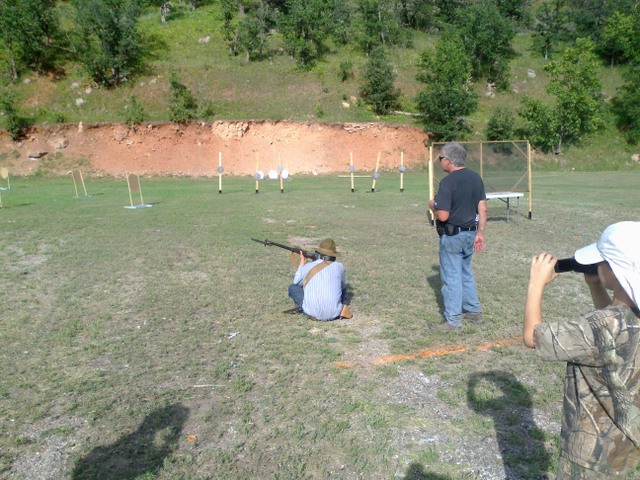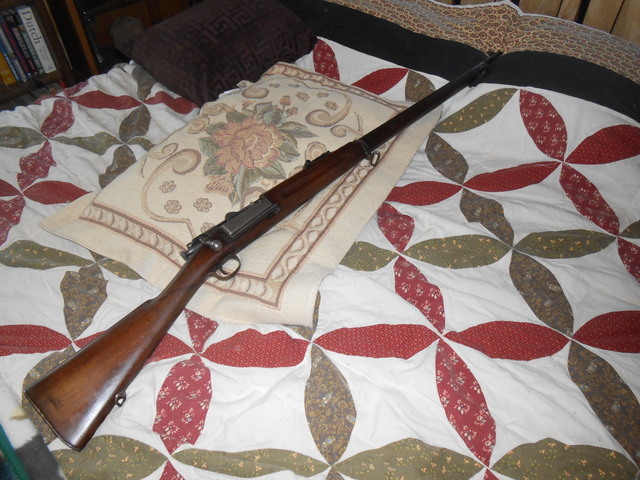You are using an out of date browser. It may not display this or other websites correctly.
You should upgrade or use an alternative browser.
You should upgrade or use an alternative browser.
Krag owners please HELP!
- Thread starter cat9x
- Start date
I'm not a Krag expert, but I'd say yards, based on this bit about the M-14 being the first metric gun in 1957.
Military[edit source]
The U.S. military uses metric measurements extensively to ensure interoperability with allied forces, particularly NATO STANAGs, "standardization agreements". Ground forces measure distances in "klicks", slang for kilometers. Most military firearms are measured in metric units, beginning with the M-14 which was introduced in 1957,[23] although a few legacy exceptions exist, such as .50-caliber guns. Aircraft ordnance is normally measured in pounds. Heavy weapon caliber is measured in millimeters. Military vehicles are generally built to metric standards. An exception is the U.S. Navy, whose guns are measured in inches and whose undersea fleet measures distances in terms of "kiloyards" (equivalent to 914.4 m), depth as "feet", and velocity, in some cases, as "feet per second". The Navy and Air Force continue to measure distance in nautical miles and speed in knots; these units are now accepted for use with SI by the BIPM.[27]
FrankenMauser
New member
It should be yards.
There were, however, some rifles produced for foreign contracts, that were graduated in meters or arshins.
If you have any more questions, the Krag Collectors Association would be your best source of information.
There were, however, some rifles produced for foreign contracts, that were graduated in meters or arshins.
If you have any more questions, the Krag Collectors Association would be your best source of information.
Mike Irwin
Staff
Definitely yards.
Yards:
The 1901 Krag sights are unique in they have a variety of sighting options.
Look at the picture you posted. First take the slider. When the sight is laid down as pictured. Using the rear notch you set the rifle on Battle Sight. On the left side of the sight is the letter "B" and yard markings. The rifle is carried in normal conditions with the slider set so the notch is lined up on the B, (BSZ) which would is set for 375 yards. You can use this sight for 100 to 400 yards.
The other mark on the slider is used when the sight is flipped up. It goes from 450 to 1900 yards.
The peep in the rear of the slider (when the sight is flipped up can be used from 100 to 1775 yards.
The at the top of the sight when its flipped up is set at 2000 yards.
At the front of the sight is a lever that you loosen so you can pivot the rear sight for windage changes. The windage marks on the rear sight are 0.04 inches a part. each movement per mark moves the impact 5.56 in at 100, 11.74 at 200, 17.69 at 300 and 58.8 at 1000 yards, (rather course).
The sights settings are based on a 220 gr RN bullet with a MV of 2000 fps.
I use that load in my Krag with the 1901 sights and found the sight markings are pretty accurate. I find the peeps a little slow to find the front sight so for fast shooting I use the notch on the slider. I don't shoot this rifle much past 400 yards any way, but I have done it, its just not that fast.
I used my '98 Krag w/1901 sights in a three gun match and it worked quite well, except it's slower to re-charge the mag then the ARs most people were using. One stage had some really close balloon targets and since I was limited to six rounds they let me use the bayonet on the balloons to save one reload. When the sight is laid down you can side it back a bit short of the 100 yard mark that allows you to shoot 25-50 yards. (Bayonet changed impact but not too bad at close range).
It was quite an experience.

The 1901 Krag sights are unique in they have a variety of sighting options.
Look at the picture you posted. First take the slider. When the sight is laid down as pictured. Using the rear notch you set the rifle on Battle Sight. On the left side of the sight is the letter "B" and yard markings. The rifle is carried in normal conditions with the slider set so the notch is lined up on the B, (BSZ) which would is set for 375 yards. You can use this sight for 100 to 400 yards.
The other mark on the slider is used when the sight is flipped up. It goes from 450 to 1900 yards.
The peep in the rear of the slider (when the sight is flipped up can be used from 100 to 1775 yards.
The at the top of the sight when its flipped up is set at 2000 yards.
At the front of the sight is a lever that you loosen so you can pivot the rear sight for windage changes. The windage marks on the rear sight are 0.04 inches a part. each movement per mark moves the impact 5.56 in at 100, 11.74 at 200, 17.69 at 300 and 58.8 at 1000 yards, (rather course).
The sights settings are based on a 220 gr RN bullet with a MV of 2000 fps.
I use that load in my Krag with the 1901 sights and found the sight markings are pretty accurate. I find the peeps a little slow to find the front sight so for fast shooting I use the notch on the slider. I don't shoot this rifle much past 400 yards any way, but I have done it, its just not that fast.
I used my '98 Krag w/1901 sights in a three gun match and it worked quite well, except it's slower to re-charge the mag then the ARs most people were using. One stage had some really close balloon targets and since I was limited to six rounds they let me use the bayonet on the balloons to save one reload. When the sight is laid down you can side it back a bit short of the 100 yard mark that allows you to shoot 25-50 yards. (Bayonet changed impact but not too bad at close range).
It was quite an experience.

Kraig,
Thank you so much for all that terrific information! I've looked and looked and learned more reading your post than anywhere else.
This particular sight is not mounted on a Krag however, it's mounted on a Remington Model 8 autoloading rifle used by Maj. John Hession for target work. Gun was made in 1909 and modified for him personally. Pretty cool sight although the yardage is a bit generous for the 25 Remington cartridge!
Thank you so much for all that terrific information! I've looked and looked and learned more reading your post than anywhere else.
This particular sight is not mounted on a Krag however, it's mounted on a Remington Model 8 autoloading rifle used by Maj. John Hession for target work. Gun was made in 1909 and modified for him personally. Pretty cool sight although the yardage is a bit generous for the 25 Remington cartridge!
Mike Irwin
Staff
Isn't that basically the same kind of sight set up that was on the Springfield 1903?
g.willikers
New member
Meters overseas and yards in the US?
Jim Watson
New member
I never heard of any Foreign Power using the .30 Army (.30-40 Krag.)
Mike Irwin
Staff
"I never heard of any Foreign Power using the .30 Army (.30-40 Krag.)"
They didn't.
What he meant is that during World War I, in particular, US companies manufactured rifles for France and Imperial Russia.
The French rifles (made by Remington, I believe) had rear sights graduated in meters, which was the French measurement standard.
Russian rifles, Moisin Nagants manufactured by Westinghouse and Model 95 lever actions from Winchester, had their rear sights graduated in arshins, which was an old Imperial Russian measurement.
For many years afterwards (through the 1950s, I believe) Remington made ammo in both 8mm Lebel and 7.62x54R Russian to stoke the surplus rifles that were made in the US, but which never made it to either France or Russia due to the end of the war for those combatants.
They didn't.
What he meant is that during World War I, in particular, US companies manufactured rifles for France and Imperial Russia.
The French rifles (made by Remington, I believe) had rear sights graduated in meters, which was the French measurement standard.
Russian rifles, Moisin Nagants manufactured by Westinghouse and Model 95 lever actions from Winchester, had their rear sights graduated in arshins, which was an old Imperial Russian measurement.
For many years afterwards (through the 1950s, I believe) Remington made ammo in both 8mm Lebel and 7.62x54R Russian to stoke the surplus rifles that were made in the US, but which never made it to either France or Russia due to the end of the war for those combatants.
The U.S. Krag was made only by Springfield Armory and only for the U.S. services. Some may have been sold overseas, after they became surplus, but there were no foreign contracts or metric sights. The Krag-Jorgensen system was used by Denmark (1889) and Norway (1894), but they differ from the rifle adopted by the U.S.
In that period, the sights were given model numbers separate from the model of the rifle or carbine they were put on. The Model 1901 sight was the predecessor of the Model 1905 sight for the Model 1903, which originally had the Model 1903 sight, very much like the Model 1902.
IMHO, the Model 1901 sight is a poor one, but the Model 1905 sight has to be the worst sight ever put on a combat rifle. In that day, Army Ordnance was run by the target shooters, and they (like their descendants today) wanted to have every possible gadget and gimmick. So the 1905 sight has five (5) different aiming points, a rear sight leaf made to account for drift, etc., etc. And the windage marking in artillery mils!! (Yes, I know what those are, but I can't tell you everything! Look it up.)
All in all a horrible mess, and totally useless on a real battlefield, as the AEF soon found out. But not surprising that a Model 1901 sight would have been liked by a target shooter.
Jim
In that period, the sights were given model numbers separate from the model of the rifle or carbine they were put on. The Model 1901 sight was the predecessor of the Model 1905 sight for the Model 1903, which originally had the Model 1903 sight, very much like the Model 1902.
IMHO, the Model 1901 sight is a poor one, but the Model 1905 sight has to be the worst sight ever put on a combat rifle. In that day, Army Ordnance was run by the target shooters, and they (like their descendants today) wanted to have every possible gadget and gimmick. So the 1905 sight has five (5) different aiming points, a rear sight leaf made to account for drift, etc., etc. And the windage marking in artillery mils!! (Yes, I know what those are, but I can't tell you everything! Look it up.)
All in all a horrible mess, and totally useless on a real battlefield, as the AEF soon found out. But not surprising that a Model 1901 sight would have been liked by a target shooter.
Jim
FrankenMauser
New member
Pretty much. And on the Springfield Trapdoor the preceded it.Isn't that basically the same kind of sight set up that was on the Springfield 1903?
Mike Irwin
Staff
So, basically, it's a later version of a Buffington sight?
Interesting.
Interesting.




